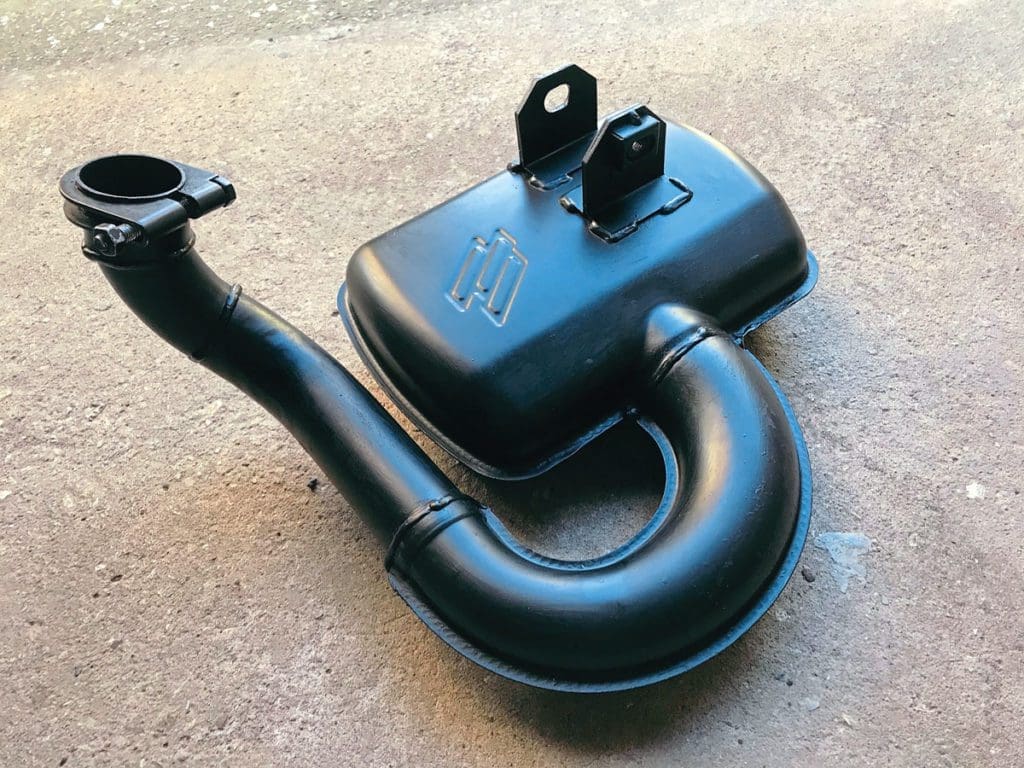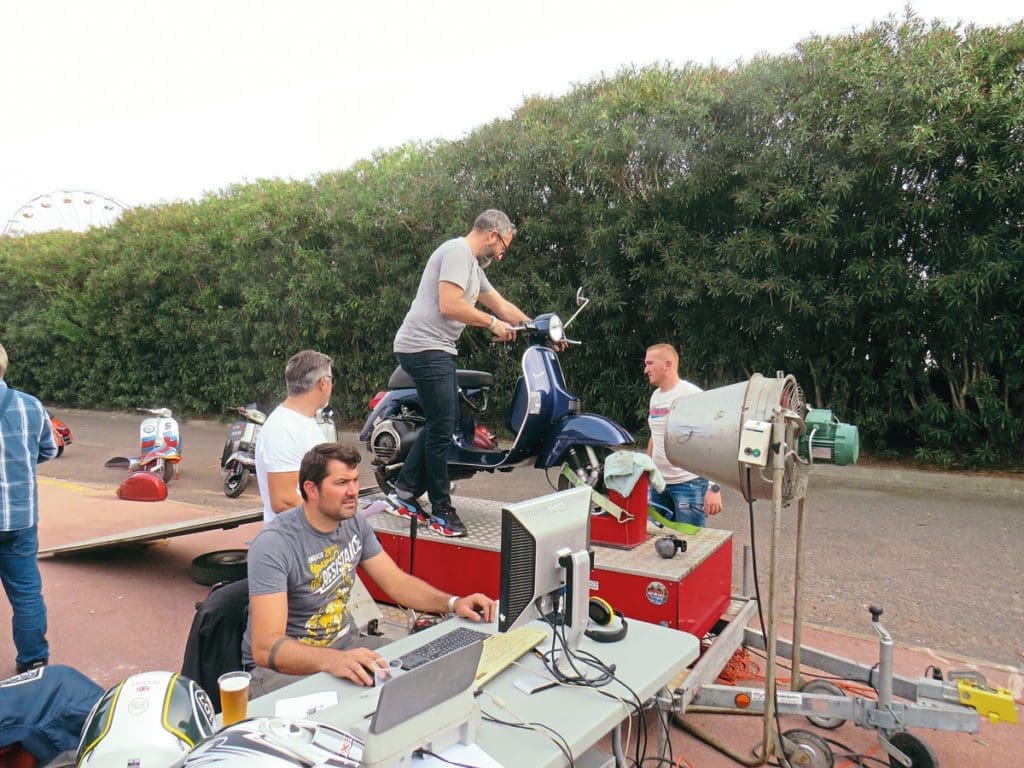Last week Stan explained how we’d built our two Polini 210 test scoots. This week he tells you how they ride.

For anyone who wasn’t paying attention at the back I’ll quickly explain the story so far; if you were with us for the first instalment feel free to skip past this section. It was way back in 2016 that my PX started fighting back, a series of holed pistons were eventually traced to a faulty fuel tap that would, without warning, reduce the fuel supply to a trickle, leaning out the mixture with catastrophic results. During the rebuild a Polini 210 kit was fitted. This was a simple bolt-on affair. Gearing was altered by changing to a 24-tooth primary, and a larger carb together with a Polini exhaust were fitted.
Big Blue
- Scooter: 2002 Vespa PX200E Disc.
- Engine specification
- BHP: 18.7.
- Casings: Piaggio.
- Kit: Polini 210 (alloy.)
- Porting: Mike Preston.
- Carb: 26mm Dell’Orto with autolube (Rich Tyler Engineering conversion).
- Crank: 57mm welded Mazzucchelli.
- Clutch: SIP banded.
- Gearbox: Piaggio with Malossi 24/35 Straight Cut Gear Kit.
- Exhaust: SIP 3.

In contrast Brad was also having problems with his Polini-equipped PX. These were due to a rather sloppy engine build by the scooter’s previous owner and as his engine required the casings to be split we thought that it would be a good idea for him to go further, matching the ports, fitting a straight cut Malossi 24/63 primary drive while also upgrading the carb. While I’d tried a SIP 3 exhaust on my kit and couldn’t get on with it, Brad found the SIP 3 to be a perfect travelling companion. The full specifications for both scooters are included elsewhere in this article. Now you’re up to speed, let the review commence.
The best laid plans…
Of course, no review is complete without a dyno test and after trying various exhaust, carb and gearing combinations Brad’s finally emerged with a figure of 18.7bhp. This was around 2.5bhp higher than the bolt-on approach. Round one had gone to the ported engine.
The dyno results were unsurprising, but they only tell part of the story. What really matters is how a kit works in the real world and for that we needed a road trip.
As Brad has business which regularly takes him to the South of France our plan was to combine business with pleasure. We’d throw both scooters in the back of his van and combine a little work with pleasure, taking the scooters along the Mediterranean coast from Narbonne to Saint-Tropez. This would be a test in the best traditions of high-budget TV shows, stunning locations, mountain roads and plenty of good food and wine. Sadly the pandemic had other ideas and in the end we settled for the South of England on a very grey weekend.
Bend it like Burnham
First out of the bag was a run out to Burnham-on-Crouch. As a proud Yorkshireman I’m obviously very reluctant to concede that any other county can match its charms, but I have to admit the route from Rayleigh to Burnham is one of my favourites. Don’t be fooled by looking at the route on a map, the road is full of sweeping curves interspersed with short straights. There are also some lovely cafes on arrival and all things considered it’s a quality afternoon out. It’s also a good route to test the type of riding most of us enjoy and the two scooters were surprisingly well matched. Both felt far more pleasing to ride than a standard ‘P2’ and as we vied for position along the sweeping country lanes, both responded instantly to throttle input. If it had been BSSO, where every tenth of a second counts, I’m certain that we’d have discovered some marked differences in performance. For two mates out on an afternoon thrash there was nothing to choose between the two approaches. Even though Brad’s a more aggressive rider than I am and I need to eat a few less pies if I want to come down to his weight, he couldn’t shake me off. I feel justified in declaring the Bendy Burnham Challenge a draw.

London Town
The following day we headed for Central London, a trip that required a long thrash down the A13. Here the 24-tooth conversions proved their worth with both scoots purring along happily without over revving at cruising speed. At dual carriageway speeds, even with my less powerful motor, there was enough power left to dispatch the lorries which often prove impossible to punch past on a standard scooter.

Unfortunately the A13 was also the road that separated our two scooters. Although I’d matched Brad around corners, he’d always been faster on the straight. Once I’d reached my cruising speed his ported motor kept on pulling away and if we wanted to match speed, Brad had to ease off the throttle or I had to make my kit work for its money. This was also the case from a rolling start. Coming out of roadworks in third gear we rode side by side, both nailing the throttle as we passed the final speed camera. It would be an exaggeration to say that Brad left me standing, but the difference in acceleration was very noticeable. Once again Brad’s engine managed to pull off a win.
One problem with tuned engines is that they’re often difficult to live with around town; not so with the Polini. Both scooters were a pleasure to ride in slow traffic, with no need for high revs or clutch slipping to get away at junctions. The Polini produces a broad spread of power; in fact it was very similar to riding a standard P2, just more fun. Adding this draw to our tally, Brad had two clear wins while the best I’d been able to manage was two score draws.
Budget Black
- Scooter: 1985 Motovespa, PX200E Iris.
- Engine specification
- BHP: 16.3.
- Casings: 1995 Piaggio PX200E.
- Kit: Polini 210 (alloy).
- Porting: Nil.
- Carb: BGM 26mm with autolube.
- Crank: Piaggio (standard).
- Clutch: Piaggio standard basket with BGM CR80 plates.
- Gearbox: Standard Piaggio with BGM 24-tooth helical primary gear.
- Exhaust: Polini.

Fuel’s out for summer
At the risk of sounding like a proper motoring journalist I was confident of winning the fuel consumption round. Unfortunately, I was disappointed. Whether around town, on country lanes or on A roads, my kit consistently used between 10 and 20% more fuel than Brad’s ported kit. We mulled this over for quite some time and the only explanation we could think of was that my engine was constantly working harder to keep up.
Having completed several test runs, Brad reports 5100 revs at 60mph and 8000 revs at 79mph (SIP speedo readings). I don’t have a rev counter fitted but can say that I wouldn’t want to push my kit any harder than when I recorded 73mph by GPS.
The winner is…
With more power, faster acceleration, a higher top end speed and better fuel consumption Brad’s approach seems to be the clear winner. He’s also got an engine that’s capable of being taken to the 30bhp mark. However that verdict ignores the cost of getting there. If an engine needs splitting then this is the obvious route to take. If you’re confident and competent to do the work yourself, again it’s a no-brainer. However if you’re relying on a workshop to do the rebuild and porting work for you I’d be very surprised if the labour bill alone would nudge under four figures.

Contrast that with my approach. So long as you’ve everything laid out in front of you and an average set of tools it’s possible for a reasonably competent owner to start the job over a breakfast bacon butty and do the test ride on the way to pick up a curry that same evening. The result of that day’s work is a P2 that’ll cruise all day at 60mph without detonating and still have enough left for an overtake. It’ll also be fun on country lanes while still being docile enough to ride around town. Despite Brad’s scooter winning on points we both agreed that the biggest ‘bang for bucks’ is achieved by simply bolting the kit on.
Either way it’s a winner, all we need to do now is see how the two approaches stand the test of time. I feel a proper road trip coming on…

Le Dyno
Although our road test never made it to France, Brad has paid a couple of flying visits and while poking around the Perpignan custom show he found a Polini 210 kitted PX being run up on the dyno. This motor had been fitted with a 30mm Dell’Orto and recorded 19bhp. An extra 0.5bhp than Brad’s scooter but at the expense of losing the autolube feed.
Words: Stan
Images: Stan/Brad



